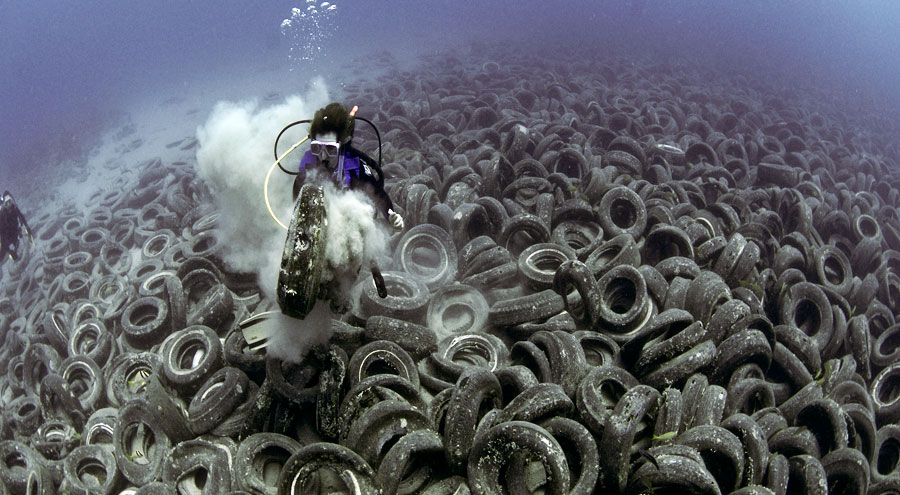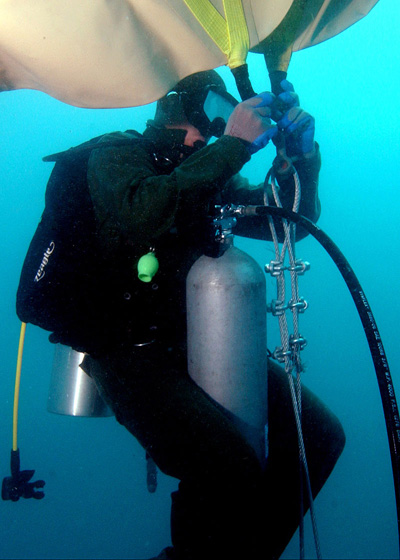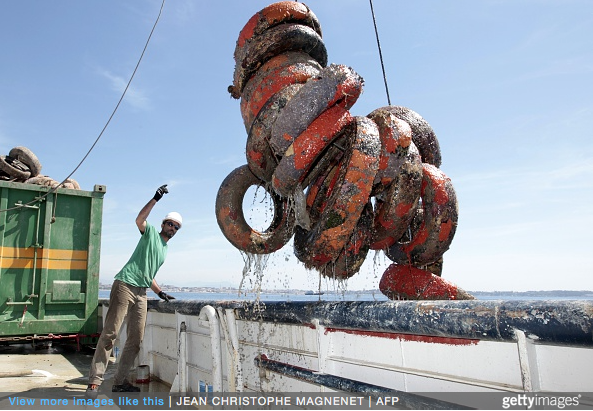It sounded like a great idea at the time – sinking millions of worn tires into the ocean to provide safe haven for sea life and a growing habitat for fish, corals, and thousands of other animals. What started as a noble cause, however, has ended up to be an ecological disaster.
One such reef that is in the process of being removed is just off the French Riviera in France, where hundreds of thousands of tires were dropped off in the 1980s in piles and rows in an attempt to restock the waters with marine life. The plan, however well-intentioned, has proved to be almost entirely worthless, and in fact causing more problems than it solved.
The tires were dropped to a depth of approximately 30 meters – about 100 feet – off the Mediterranean coast. In addition to tires, hundreds of thousands of other objects were also dropped to provide underwater structure, and the result isn’t pretty.
Only a few species of sponges actually ended up growing on the tires, and undersea currents carried the tires away, crushing corals and plant life on the seabed as they dragged along the bottom. Some environmentalists also claim the tires have also released toxic hydrocarbons into the sea. “Things didn’t work as we had imagined at the time,” Elodie Garidou of France’s protected marine areas unit, AMP, told Le Monde.
Divers removed the tires in batches of 10 to 30 tires at a time, stringing them together in necklaces which were then winched up by crane to boats and barges on the surface. The tires will now be discarded in landfills as is more traditionally done.
The cleanup in France is just now being completed, and the goal was to have it done before the famous Cannes film festival takes place this month.
But the thousands of tires dumped in Florida pales in comparison to the 700,000 tires dropped off the coast of Florida to create the infamous Osbourne Reef. The reef is comprised of more than 2 million tires placed there in 1972.

Tires in Ft. Lauderdale, Florida, dumped in the 1970s in an attempt to establish an artificial reef. Photo: Steve Spring/Marine Photobank.
The Osbourne reef was the subject of an ambitious expansion project utilizing old and discarded tires. In 1972, Broward Artificial Reef Inc. (BARINC) proposed the construction of an enlarged artificial reef to Broward County as a way to both dispose of old tires as well as lure more game fish to the area. Gregory McIntosh, an employee of BARINC, lauded the project to the attendees of a 1974 conference on artificial reefs: “Tires, which were an esthetic pollutant ashore, could be recycled, so to speak, to build a fishing reef at sea.”

More details
A U.S. Navy Diver attached to Mobile Diving Salvage Unit (MDSU) 2 Det. 6 prepares a lift bag to salvage tires off the coast of Fort Lauderdale, Florida. (Public domain image)
With endorsement of the project by the US Army Corps of Engineers, the Broward County government approved the project and more than 100 privately owned boats enthusiastically volunteered to assist with the project. Accompanied by the USS Thrush, thousands of tire bundles were simultaneously dropped onto the reef. The Goodyear Tire and Rubber Company provided equipment for the project; even supporting the project so far as to drop a gold-painted tire from a Goodyear Blimp to christen the site. The culmination of the project was the deposit of over 2,000,000 tires bound with steel clips over 36 acres of the ocean floor, approximately 7,000 feet offshore and at a depth of 65 feet.
Ultimately, marine life didn’t take to the man-made reef, and the majority never even had the opportunity to do so. When placed there, the majority were bound together with nylon or steel clips (or bands). As there were no exceptional efforts made to ensure the non-corrosivity of the steel restraints, they ultimately corroded away, resulting in the loosing the 2,000,000 now individual tires, which continued dragging and bouncing along the ocean bottom, pummeling anything in their path, including some large coral reefs as close as 70 feet away. In 1995, Hurricane Opal dislodged and spread over 1,000 tires onto the Florida Panhandle, and in 1998 Hurricane Bonnie deposited thousands of the tires onto North Carolina beaches.
Like the reef in France, the Osbourne artificial reef has come to be considered an environmental disaster. The cleanup if the mess was almost as unsuccessful until the military stepped in, using the cleanup, in part, as a training exercise for their divers.
In 2009, recovery began on July 24 with thirty Army and Navy divers at Hugh Taylor Birch State Park, where it was thought about 300,000 tires were caught against a natural reef. Loading the caught tires onto the Army craft Brandy Station, the first day’s haul brought approximately 1,400 tires ashore. Wrapping up for the year in mid-August, Coastal America’s William Nuckols told the Associated Press that cleanup efforts have thus far recovered approximately 73,000 tires from the reef, still far short of the estimated 2 million originally placed there.
In addition to Francs and the U.S., Indonesia and Malaysia mounted enormous tire-reef programs in the 1980s and are now seeing the ramifications of the failure of tire reefs, from littered beaches to reef destruction. Jack Sobel, The Ocean Conservancy‘s director of strategic conservation said in a 2002 interview that “I don’t know of any cases where there’s been a success with tire reefs.” That year, The Ocean Conservancy’s International Coastal Cleanup removed 11,956 tires from beaches all over the world.

